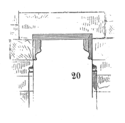
Classic definition of lintel
A lintel is defined as a horizontal block that spans the space between two supports in classical western architecture.[1] In classical western construction methods, defining lintel by its Merriam-Webster definition, a lintel is a load-bearing member and is placed over an entranceway.[2] Thus in ancient classical architecture, the lintel often rested on pillars made of piled stones such as in the building of the Treasury of Atreus in Mycenae, Greece. In architecture around the world however, a lintel is not considered (as it is in the very narrow view of classical architecture) as purely an element of the Post and lintel.

Lintel 24, structure 23, Yaxchilan, published by Charnay, 1885
Decorative use[]
The use of the lintel form (rather than as a construction technique) has been employed in the architecture of many cultures over time. In non-classical architecture a lintel was frequently used for purely ornamental purposes, having no structural function. For example, the architectural use of a lintel is purely ornamental in the case of Indian rock-cut architecture. Prehistoric Buddhist temples in India were wooden structures with load-bearing lintels above openings. Subsequently excavated rock cave temples were preferred as more durable, allowing creative ornamental use of classical architectural elements; the carved stone lintels were not load-bearing. Highly skilled artisans were able to simulate the look of a wood, imitating the nuances of a wooden structure and the wood grain in excavating cave temples from monolithic rock. This use of the lintel form was purely decorative and not load-bearing.[3]
The Maya civilization was known for its spectacular art and monumental architecture. The Mayan city of Yaxchilan specialized in the carving of ornamental stone lintels. At the archaeological site on the Usumacinta River, there are 58 lintels spanning the doorways of major structures. Among the finest Mayan carving to be excavated anywhere are three temple door lintels that feature narrative scenes of a queen celebrating her husband's anointing by a god. The earliest were commissioned in 723 CE.[4]
Decorative examples[]
See also[]
| Wikimedia Commons has media related to Category:Lintels as art that may be added |
| Wikimedia Commons has media related to Category:Lintels that may be added |
- Marriage stone
- Rock-cut architecture
Notes[]
- ↑ "Glossary of Medieval Art and Architecture - Lintel". University of Pittsburgh. http://www.pitt.edu/~medart/menuglossary/lintel.htm. Retrieved 2007-06-25.
- ↑ "lintel". Merriam Webster. http://www.webster.com/cgi-bin/dictionary?sourceid=Mozilla-search&va=lintel. Retrieved 2007-06-25.
- ↑ Keay, John (2000). India: A History. New York: Grove Press. pp. 124–127. ISBN 0802137970.
- ↑ Nikolai Grube &, Simon Martin (2000). Chronicle of the Maya Kings and Queens. London: Thames & Hudson Ltd.. pp. 117, 125. ISBN 0-500-05103-8.
This page is being imported from Wikipedia, to create a Wikidwelling stub or article. These steps need to be completed:
The original article was at Lintel (architecture). The list of authors can be seen in the history for that page. The text of Wikipedia is available under the CC-BY-SA 3.0 license. |








